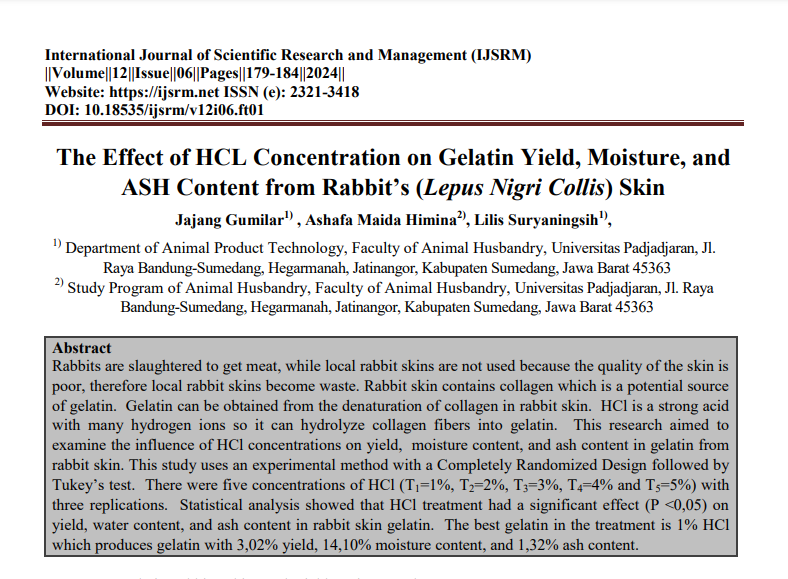The Effect of HCL Concentration on Gelatin Yield, Moisture, and ASH Content from Rabbit’s (Lepus Nigri Collis) Skin

Submission to VIJ 2024-06-23
Keywords
- gelatin, rabbit’s skin, HCl, yield, moisture, ash content
Copyright (c) 2024 Jajang Gumilar, Ashafa Maida Himina, Lilis Suryaningsih

This work is licensed under a Creative Commons Attribution 4.0 International License.
Abstract
Rabbits are slaughtered to get meat, while local rabbit skins are not used because the quality of the skin is poor, therefore local rabbit skins become waste. Rabbit skin contains collagen which is a potential source of gelatin. Gelatin can be obtained from the denaturation of collagen in rabbit skin. HCl is a strong acid with many hydrogen ions so it can hydrolyze collagen fibers into gelatin. This research aimed to examine the influence of HCl concentrations on yield, moisture content, and ash content in gelatin from rabbit skin. This study uses an experimental method with a Completely Randomized Design followed by Tukey’s test. There were five concentrations of HCl (T1=1%, T2=2%, T3=3%, T4=4% and T5=5%) with three replications. Statistical analysis showed that HCl treatment had a significant effect (P <0,05) on yield, water content, and ash content in rabbit skin gelatin. The best gelatin in the treatment is 1% HCl which produces gelatin with 3,02% yield, 14,10% moisture content, and 1,32% ash content
References
- AOAC (the Association of Official Analytical Chemist). 2019. Official Methods of Analysis. Inc, Washington, DC.
- Astawan, M., Hariyadi, P., dan Mulyani A. 2002. Analisis sifat rheologi gelatin dari kulit ikan cucut. Jurnal Teknologi dan Industri Pangan. 13(1): 38-46.
- Dayva, P. M., Lia, H., dan Suraiya, N. 2018. Pemanfaatan limbah kulit ikan tuna sirip kuning (Thunnus albacares) sebagai gelatin: Hidrolisis menggunakan pelarut HCl dengan konsentrasi berbeda. Acta Aquatica: Aquatic Sciences Journal : 81-87.
- Endang, M., Nora, I., dan Muhamad A. W. 2018. Ekstraksi Gelatin Pada Tulang Ikan Belida (Chitala lopis) Dengan Proses Perlakuan Asam Klorida. Jurnal Kimia Khatulistiwa 7(4): 114-123.
- Feng X., Liu T., Ma L., Dai H., Fu Y., Yu Y., Zhu H., Wang H., Tan H., Zhang Y. 2022. A green extraction method for gelatin and its molecular mechanism. Food Hydrocolloids 124 (2022) 107344. https://doi.org/10.1016/j.foodhyd.2021.107344
- Hazmi, Y., Abdul, S. B., dan Norrakiah, A. S. 2017. Modification of chicken feet gelatin with aqueous sweet basil and lemongrass extract. Food Science Technology. 72 – 79
- Hinterwaldner, R. 1977. Technology of gelatin manufacture. Di dalam Ward A.G. and Courts, A. (eds.). The Science and Technology of Gelatin. Academic Press, New York. 135.
- Gumilar, J., Putranto, W. S., dan Wulandari, E. 2019. Kualitas gelatin yang diproduksi dari limbah proses shaving kulit domba menggunakan curing HCl dengan konsentrasi dan waktu yang berbeda. Universitas Padjadjaran. Sumedang. 5.
- Gumilar, J., Suryaningsih L., Setiawan D. F. 2023. The Use Of Various Hydrochloric Acid Concentration Levels On The Rabbit Bone Gelatin Quality. Jurnal Ilmu Ternak Universitas Padjadjaran. 23(2):154-160. DOI: 10.24198/jit.v23i2.50861.
- Gumilar J. dan Pratama A. 2018. Produksi dan Karakteristik Gelatin Halal Berbahan Dasar Usus Ayam. Jurnal Teknologi Industri Pertanian 28 (1):75-81.
- Ilona, K., Elzbieta, S., Maria, S., Sadowo., Wiktor, K., dan Celina. N. 2007. Effect of Extracting time and Temperature on y Kolodziejskaield of gelatin from different fish offal. Food Chem.107(2). 704.
- JECFA. 2003. Edible Gelatin. Didalam Wini, T., Mala, N., dan Ima, H. S. 2012. Ekstraksi Gelatin Kulit Ikan Kakap Merah (Lutjanus sp.) dengan Proses Perlakuan Asam.Vol. 15 No. 3. 246.
- Lin, L., Regenstein, J.M., Lv, S., Lu, J., Jiang, S., 2017. An overview of gelatin derived from aquatic animals: Properties and modification. Trends Food Sci. Tech. 68,102–112. https://doi.org/10.1016/j.tifs.2017.08.012.
- Nazilatun Ni’mah. 2017. Pengaruh Konsentrasi HCl terhadap Proses Demineralisasi pada Produksi Gelatin dari Tulang Ayam Broiler (Gallus dometicus). Universitas Islam Negeri Maulana Malik Ibrahim Malang. 42.
- Onouma, K., Thammarat, K., Soottawat, B., dan Hideki, K. 2015. Characteristics of gelatin from swim bladder of yellowfin tuna (Thunus alabacores) as influenced by extracting temperatures. Italian Journal of Food Science, 27(3), 366 – 374.
- Rapika, Zulfikar, dan Zumarni. 2016. Kualitas Fisik Gelatin Hasil Ekstraksi Kulit Sapi Dengan Lama Perendaman Dan Konsentrasi Asam Klorida (HCl) Yang Berbeda. Universitas Islam Negeri Sultan Syarif Kasim Riau. 30.
- Said, M. I., Likadja, J.C., Hatta, M. 2011. Pengaruh waktu dan konsentrasi bahan curing terhadap kuantitas dan kualitas gelatin kulit kambing yang di produksi melalui proses asam. JITP, 1 (2). 119 – 128.
- Santoso, A.W. 2001. Pengaruh Perendaman Kosentrasi Asam Klorida dan Lama Perendaman terhadap Kualitas Gelatin yang Dihasilkan dari Limbah Kulit Belahan. Di dalam Jurnal Ekstraksi Gelatin Dari Tulang Ikan Tenggiri Melalui Proses Hidrolisis Menggunakan Larutan Basa. 9.
- Sebastian, M. 2014. Industrial Gelatine Manufacture – Theory and Practice. Agris Record. Toronto.
- Schrieber R dan Garies H. (2007). Gelatin Handbook: Theory and Industrial Practice. Wiley-VCH.
- See, S.F., Hong, P.K., Ng, K.L., Wan Aida, W.M., dan Babji, A.S. 2010. Physicochemical properties of gelatins extracted from skins of different freshwater fish species. International Food Research Journal, 17, 809-816.
- SNI 06-3735. 1995. Mutu dan Cara Uji Gelatin. Dewan Standarisasi Nasional. Jakarta.
- Suryati., Nasrul, Z.A., Meriatna., Suryani. 2015. Pembuatan dan Karakterisasi Gelatin dari Ceker Ayam dengan Proses Hidrolisis. Jurnal Teknologi Kimia Unimal 4 : 2. 66-79.
- Winarn, F. G. 2002. Kimia Pangan dan Gizi. PT. Gramedia Pustaka Utama, Jakarta.